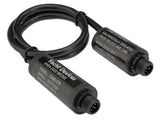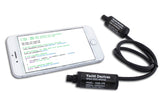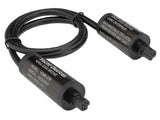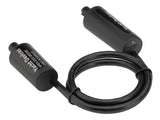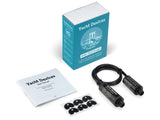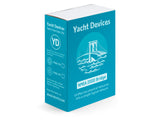NMEA Bridge YDNB-07
Yacht Devices NMEA Bridge unifies two physical NMEA 2000 networks into a single logical network, smoothly exchanging messages between them. The Device also supports filtering and processing of transmitted messages.
This can accomplish the following tasks:
- Bypass the physical limits of NMEA 2000 networks concerning length of networks (100 meters for regular cable and 250 meters for heavy or mid-type cable) and concerning the maximum number (50) of physical devices attached to the network. On a network with address capacity of 252, multiple bridges can be engaged to expand to around 250 physical devices.
- Isolate devices from each other. Using the simple filter, you can block transmission of all or of selected messages from a given device in a separate subnet.
- Ensure proper functioning of equipment. Correct the transducer offset of the depth sounder, or "delete" invalid data in messages from equipment that is only partially operational using a 2- or 3-line script.
- Ensure compatibility of equipment from different generations. You can create and send any type of NMEA 2000 message using data from other messages in the network.
- Diagnose malfunctions in the NMEA 2000 network. The Device can record network messages and debug data from custom programs on a MicroSD card in a text file. You can view the data in a standard text editor on a smartphone or tablet with a MicroSD slot, there is no need for a computer. You can even create and edit programs for the Device right on your phone!
- Free diagnostics software is supplied for Microsoft Windows, Mac OS X and Linux. It allows to play, view and convert binary log files with NMEA 2000 messages from both CAN interfaces.
- Safely connect devices that do not meet NMEA 2000 standards. One of the CAN-interfaces on the device has high-voltage galvanic isolation and can operate at a higher supply voltage.
- Create gateways for networks based on CAN protocol operating at a speed of 250 kbps. The programming language of the device is not designed for full-fledged applications, but one can create, for example, a gateway from a J1939 network to NMEA 2000.

Picture 1. Scheme of a typical installation
The Bridge is equipped with two connectors (on CAN1 and CAN2 network interfaces) compatible with Raymarine SeaTalk NG or with two connectors compatible with NMEA 2000 Micro Male (used in Garmin networks). For other networks, an adaptor cable may be required. Drawing of connectors is available in Appendix C of the User Manual.
The Bridge contains a built-in compiler of a simple programming language. You can create programs on any device with a MicroSD socket and a text editor, and upload programs to the Bridge with MicroSD card.
# CAN1 - NMEA 2000 network with instruments # CAN2 - NMEA 2000 network with MFD FW_CAN1_TO_CAN2=ON FW_CAN2_TO_CAN1=ON CAN2_HARDWARE_FILTER_1=0x00EF0000, 0x00FF0000 # addressable proprietary messages PGNS_TO_ASSEMBLY=0x1F513 # pre-assembly for this fast packet message # Log distance handler match(CAN1,0x1F51300,0x1FFFF00) { set(DATA + 6, UINT32, get(DATA + 6, UINT32) - 1852000) send() # 1000 nm off } # Actual pressure handler match(CAN1,0x1FD0A00,0x1FFFF00) { send() # forward the original message A = get(DATA + 2, UINT8) # extract the data type if (A == 0) # is it atmospheric pressure? { B = get(DATA+3, INT32) # extract the pressure value if (B != 0x7FFFFFFF) # check the validity of the value { set(1, UINT8, 6) # change PGN from 0x1FD0A to 0x1FD06 set(DATA + 1, UINT32, 0xFFFFFFFF) # set the unused fields set(DATA + 5, UINT16, B / 1000) # convert and set pressure send(CAN2) # send Environmental Parameters to CAN2 set(0, UINT8, addr()) # replace the address with the address of the Bridge send(CAN1) # send Environmental Parameters to CAN1 } } }
Picture 2. Example of a program
The program can dump all NMEA 2000 messages and program variables to a text file on a MicroSD card. The Brige can also save all messages from both interfaces to a binary log files (.CAN format) which can be opened, viewed and converted with the free CAN Log Viewer tool. This may be extremely useful for program debugging or network diagnostics.
Programming the Bridge requires the knowledge of NMEA 2000. A copy of the NMEA 2000 standard can be purchased from the National Marine Electronics Association: http://www.nmea.org.
The cable between the two interfaces of a Bridge is
For additional technical details, please see the User Guide and FAQ.








